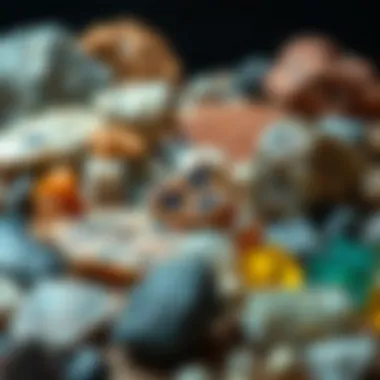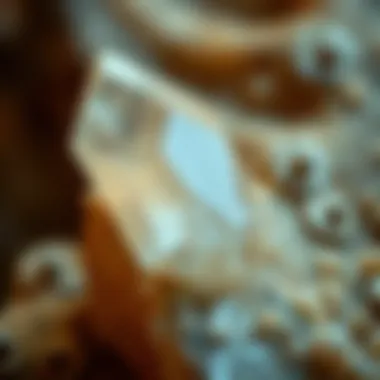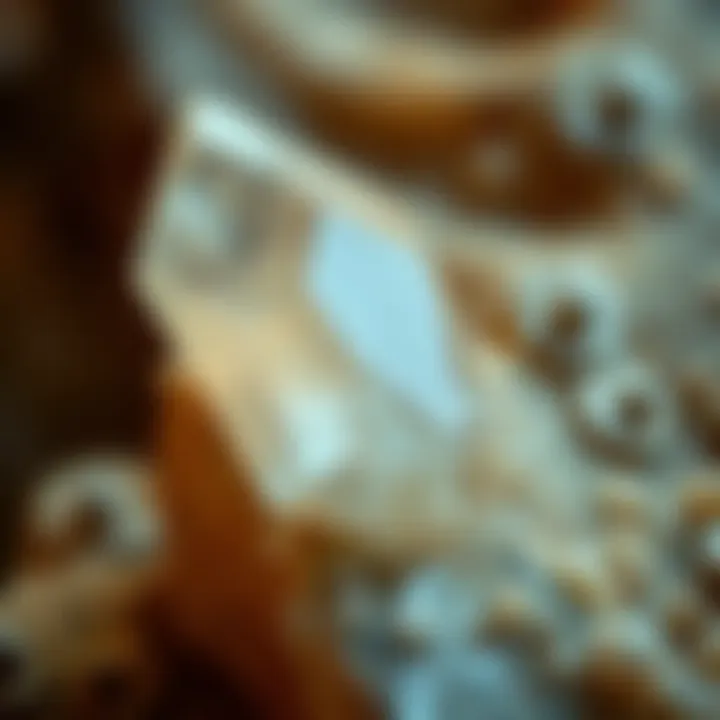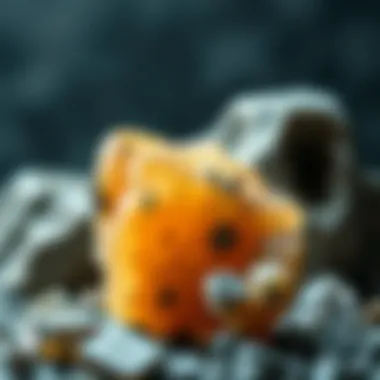Exploring the Vibrant Market for Rocks and Minerals


Intro
Understanding the market for rocks and minerals can be a riveting journey for both collectors and enthusiasts. Every piece of rock, whether it’s a glittering specimen of quartz or a dull-looking shale, has its own story to tell. While some folks might just see rocks as, well, rocks, true aficionados recognize the enduring beauty and value these geological treasures possess. This article aims to untangle the complexities of the rock and mineral market, providing insights on how to classify, evaluate, and navigate the purchasing process effectively.
Whether you're just dipping your toes into the world of collecting or you've been in it for a while, the knowledge shared here will assist you in making informed decisions. From understanding the significance of various minerals to distinguishing genuine finds from cleverly crafted fakes, let's uncover the layered world of these natural wonders.
Featured Collectible of the Month
Overview
For this month's highlighted collectible, we turn our attention to Amethyst, a striking purple variety of quartz prized for its beauty and spiritual significance. Many collectors are drawn to its vibrant color, which ranges from deep violet to lighter lavender hues. This gemstone not only appeals to collectors but also finds its way into the hearts of many looking for metaphysical properties associated with tranquility and clarity of mind.
Historical Significance
Amethyst has a rich history that dates back thousands of years. Ancient Egyptians prized it, using it for jewelry and artifacts. The Greeks believed that amethyst could prevent intoxication, leading to its name derived from the Greek word "amethystos," meaning "not drunken." Notably, it was also a favorite among royalty, often adorning crowns and regalia. Collectors today often seek well-documented specimens to appreciate its profound cultural heritage and aesthetic value.
Identification Techniques
Visual Characteristics
When it comes to identifying rocks and minerals, paying close attention to visual traits is crucial. Consider the following properties:
- Color: The hue of a mineral can often give clues about its identity. Amethyst’s distinct purple color is a hallmark.
- Luster: How a mineral reflects light can range from metallic to dull. For instance, quartz typically has a glassy luster.
- Hardness: Utilizing the Mohs scale, you can determine how resistant a mineral is to scratching. For example, talc is very soft, while diamond tops the scale.
- Crystal Form: Some minerals form in specific shapes, such as cubic pyrite or hexagonal beryl. Observing these can aid in identification.
Resources for Identification
Several resources can assist aspiring collectors in distinguishing their finds. Here are a few:
- Books: Titles like "The Field Guide to Rocks and Minerals" provide visuals and detailed descriptions.
- Websites: Online databases such as mindat.org and geology.com offer extensive information on mineral identification.
- Apps: Digital tools such as Rockcheck can help you identify materials based on photos taken with your smartphone.
Remember, identifying rocks and minerals is both an art and a science. It takes time and practice, but the results can increase your appreciation and understanding of these natural elements.
Armed with this foundational knowledge, collectors can approach the market for rocks and minerals with a sharper eye and a deeper understanding. As you explore this rich and diverse field, may you uncover not only beautiful specimens but also fascinating stories interwoven with each piece.
Preamble to Rocks and Minerals
The world beneath our feet is not merely a foundation for buildings and roads; it is a rich tapestry woven from a plethora of rocks and minerals. Each specimen tells a story, not just about itself but about the processes that formed our planet. Understanding rocks and minerals is paramount, especially as the market for these geological treasures continues to grow.
Rocks and minerals aren't just collectibles; they are resources that contribute to various industries, from construction to technology. A couple of decades back, one might think of these items as relics, but now, as various applications become clear, their value burgeons. People from all walks of life—geologists, hobbyists, and investors—are keenly interested in the physical properties and aesthetic qualities of these items, leading to a diversified market that caters to both scientific inquiry and beauty.
Besides just beauty, knowing about rocks and minerals enlightens enthusiasts about their origins and potential uses. For instance, minerals like quartz and feldspar are not just admired for their appearance but also have practical uses in manufacturing products from glass to ceramics. Similarly, the knowledge of how these elements form extends to their extraction and processing, key areas for any collector or seller.
This article lays the groundwork for a fruitful exploration of rocks and minerals, focusing not only on their basic definitions but also highlighting their significance in geological studies. Through this journey, readers gain insights into appreciating these natural wonders deeply, increasing both their knowledge and potential economic benefits.
Defining Rocks and Minerals
Rocks are typically defined as solid aggregates composed of one or more minerals, mineraloids, or organic materials. They form the crust of our planet and come in various forms, such as igneous, sedimentary, and metamorphic. Each type has its characteristics and formation processes, making them fascinating subjects for study.
On the other hand, minerals are naturally occurring, inorganic substances with specific chemical compositions and crystal structures. They are the building blocks of rocks and often have distinct properties like hardness, luster, and color. For instance, quartz, a widely recognized mineral, is prized for its durability and beauty, making it popular among collectors and jewelers alike.
Understanding the distinction between rocks and minerals is crucial for anyone involved in this field. Collectors need to accurately identify what they have in their possession to judge its value correctly.
The Importance of Geological Studies
Studying geology and the properties of rocks and minerals is not just for scientists and academics; it is a vital field that impacts our daily lives. For instance, geological studies help in locating essential resources like oil, gas, and metals, guiding extraction processes that support economies worldwide. Furthermore, knowledge of geology plays a significant role in environmental conservation efforts, particularly as the market for natural resources expands.
Geological studies also offer insights into natural phenomena such as earthquakes and volcanic eruptions. Understanding the composition and distribution of different rocks can help predict where these events are likely to occur, thus informing safety measures and emergency planning.
The knowledge gleaned from geological study extends beyond individual benefits. It fosters a greater appreciation for Earth's history, creating awareness about how human activity affects natural systems. In essence, while an interest in rocks and minerals may start as a hobby, it can evolve into a deeper understanding of our planet, shedding light on the delicate balance of environmental stewardship.


Types of Rocks and Minerals
Understanding the variety of rocks and minerals plays an essential role in the overall discussion of the subject matter. These natural resources not only hold aesthetic value but also come with a wealth of scientific and practical significance. Collectors, for instance, often seek specific types based on their rarity, beauty, and historical relevance. This segment addresses the distinct categorizations of rocks and minerals, highlighting what sets each apart and how they contribute to both the hobby and the marketplace.
Igneous Rocks: A Deeper Look
Igneous rocks, formed from the cooling and solidification of magma or lava, are the bedrock of many geological formations. They can be categorized into two primary types: intrusive, formed beneath the Earth's surface, and extrusive, formed on the surface after a volcanic eruption. The textures and appearances of these rocks vary significantly.
- Granite and Basalt: Granite is a popular example of intrusive igneous rock, widely sought after for its aesthetic appeal in construction and decoration. Basalt, on the other hand, is more common in volcanic regions and has its own unique rugged charm.
- Collecting Tips: When collecting igneous rocks, pay attention to their texture and mineral content. A rock with a coarse texture typically indicates slower cooling time, while a fine-grained texture suggests a rapid cooling process.
Exploring igneous rocks can offer a connection to the planet’s youthful past, providing insights into volcanic activity and the formation of continental crusts.
Sedimentary Variants and Their Properties
Sedimentary rocks are a fascinating category, as they often tell a story of the Earth’s history. They form through the accumulation and compaction of mineral and organic particles, including shells, plants, and sand. This process can take millennia, leading to unique formations that are both visually and scientifically interesting.
- Limestone and Sandstone: Two prevalent examples, limestone is formed from marine organisms and often contains fossils, making it highly appealing to collectors. Sandstone, with its grainy texture, can be found in varied colors and makes an attractive choice for both collectors and builders alike.
- Collecting Considerations: When assessing sedimentary rocks, look for color variations and fossilization. These elements greatly enhance a rock’s overall value and significance in personal collections.
Understanding sedimentary rocks can deepen one’s appreciation for the intricate processes that shape our landscape.
Metamorphic Rocks: Transformations Explored
Metamorphic rocks represent a dynamic shift in the geological narrative. Formed from existing rock types—igneous, sedimentary, or even other metamorphic rocks—under high temperature and pressure, they undergo profound transformations. This category offers a dazzling array of textures and minerals that can captivate any collector.
- Schist and Marble: Schist is identifiable by its shiny, reflective surface and often contains mica, making it a favorite among mineral enthusiasts. Marble, well known for its use in art and architecture, is formed from limestone and is prized for its elegance and variety of colors.
- Collecting Tips: Keep an eye out for unusual mineral inclusions and distinct banding patterns that signal a quality specimen.
Exploring metamorphic rocks encourages the collector to consider the dynamic forces at work beneath the Earth’s surface, capturing history and beauty in each stone.
Minerals: Classification and Uses
Minerals serve as the building blocks of rocks and have extensive applications ranging from industry to jewelry. They form naturally under specific environmental conditions and can be classified based on their chemical composition and crystal structure.
- Common Minerals: Quartz, feldspar, and mica are just a few examples of minerals that are not only significant in geological terms but also economically valuable. Quartz, particularly, is used in electronics and makes a popular choice among collectors for its versatility in variety.
- Utilization: Beyond aesthetics, minerals have various practical uses. For instance, talc is used in cosmetics, while bauxite is the primary ore of aluminum.
Understanding minerals and their classifications aids collectors in making informed decisions—whether expanding their collection or considering practical applications in everyday life.
Collecting Rocks and Minerals
Collecting rocks and minerals is not just a hobby; it’s a passion that encompasses natural history, artistry, and science. The thrill of unearthing a unique specimen or a rare crystal can instill a sense of accomplishment and connection to the earth that few experiences can rival. This section aims to shed light on the significance of rock and mineral collecting by breaking it down into two parts: the essentials for beginners and advanced techniques for seasoned collectors.
Essentials for Beginner Collectors
For those just dipping their toes into this rewarding activity, starting can feel rather daunting. The first steps require understanding what materials are essential for collecting, as well as how to do so safely and ethically.
Beginner collectors should prioritize obtaining a few basic tools:
- Rock Hammer: To break rocks without damaging them too much.
- Safety Goggles: Protect your eyes while you're tapping away at rocks.
- Field Guide: Handy for identifying the types of rocks and minerals you come across.
- Backpack: A sturdy bag to haul your discoveries.
- GPS or Map: Knowing where you are in the wild is crucial for both safety and return trips.
With tools in hand, it’s time to understand where to go. Local parks, mountains, and even roadside cuttings can yield fascinating finds. Consider joining a local rockhounding club or connecting with communities online, such as on platforms like reddit.com/r/rockhounds, where beginners can gather tips and encouragement from more experienced collectors.
Understanding the ethics of collecting is equally vital. Always ensure you have permission to collect in a location and adhere to regulations to protect both the environment and the integrity of the collecting community. Leave no trace and never take more than you need.
"The earth has music for those who listen." – William Shakespeare
This quote is especially true for those who find joy in the subtle beauty of rocks and minerals. Every specimen tells a story, and collecting allows you to appreciate the extraordinary craftsmanship of nature.
Advanced Techniques for Experienced Collectors
Once a collector has built a foundational understanding, it’s time to dive deeper and refine their skills. Experienced collectors often use a variety of sophisticated techniques to enhance their collecting and evaluating methods.


- GPS and Orienteering Skills: Advanced collectors will benefit from mastering navigation skills. Investing in a good GPS device or learning how to read topographic maps will allow you to locate remote mineral deposits and less trafficked areas.
- Specialized Tools: While basic tools are essential, experienced collectors may want to invest in advanced equipment such as gemstone testers or a loupe for close inspection of mineral details. A high-quality specimen can often show hidden attributes when examined closely.
- Sample Documentation: Keeping a detailed log of each specimen collected, including the location, date, and context, enriches the value of your collection and aids in future research.
- Networking: Building connections within the community can open doors to exclusive collecting trips or insider information about rare finds. Leveraging platforms like facebook.com/groups/rockhounds can help find fellow enthusiasts who may offer insights and opportunities.
- Ethical Collecting: Staying informed about sustainable practices and being active in promoting ethical geology can elevate a collector’s standing in the community. Understanding the impact of mining and promoting responsible sourcing can help preserve natural resources for future generations.
As a seasoned collector immerses themselves in advanced techniques, they not only heighten their own collecting experience but also contribute positively to the greater rock and mineral community.
The Market Landscape
Understanding the market landscape for rocks and minerals is crucial for both collectors and sellers alike. This sector is not merely about aesthetic appeal; it involves a blend of geology, economics, and human passion. Collectors often find themselves immersed in a world where knowledge dictates value, and trends can shift like sand underfoot. By keeping an eye on current developments, enthusiasts can make educated decisions and potentially discover hidden gems.
Current Trends in Selling Rocks and Minerals
The selling landscape of rocks and minerals has witnessed significant shifts in recent years, influenced by technological advancements and changing consumer behaviors. For starters, online marketplaces have become increasingly popular, allowing enthusiasts to buy and sell globally with just a few clicks. Websites like eBay and Etsy cater to various niches, from rare fossils to vibrant gemstones. This ease of access can sometimes make it feel like everyone is in the game, yet it allows for greater competition, which can help drive prices down or, inversely, elevate them for rare finds.
Another trend is the emphasis on authenticity and provenance. Beyond just acquiring a pretty rock, more buyers now inquire about the origin of their finds. This shift toward wanting credible background stories—be it a family heirloom or a specimen ethically sourced from a reputable mine—adds an extra layer of depth to the transaction.
The rise of social media has also transformed how rocks and minerals are marketed. Collectors now often showcase their finds on platforms like Instagram and TikTok, creating a vibrant community where visual appeal goes a long way. A well-timed post can turn an ordinary collecting experience into a trending topic overnight.
Understanding Market Value and Pricing
Evaluating the market value of rocks and minerals isn’t as simple as sticking a price tag on them. Several factors come into play when determining their worth, and understanding these elements is essential for anyone participating in this market.
- Rarity and Demand: As with any collectible, rarity often dictates price. A common specimen may sell for a few dollars, while something unique, like a high-quality amethyst geode, could fetch thousands. Monitoring how many collectors are vying for a particular rock can provide insights into its market relevance.
- Quality of the Specimen: The quality aspects—like color, clarity, and overall condition—also influence pricing. For instance, a mineral with vibrant colors and few flaws will likely be valued higher than those with dull appearances or visible damage.
- Recent Sales Data: Being informed about recent sales can give you a benchmark. Websites like Mindat.org offer detailed databases where you can check the selling prices of recent transactions. This can provide a clearer picture of current market values in real-time.
- Market Fluctuations: Trends can come and go. Staying updated with geological publications and collector forums can give insights into what’s hot right now and what might be waning in interest.
As you dive deeper into this unique market, keep these factors in mind. Knowledge is your best tool, and remaining informed about fluctuations and trends will aid you in making smarter purchases or sales.
"In the world of collecting, the most valuable pieces often carry stories that go beyond mere aesthetics. Knowing the backstory adds layers to the value you are holding."
For further insights and discussions, consider visiting resources such as Wikipedia, Britannica, or engaging with fellow collectors on platforms like Reddit.
Evaluating Quality and Authenticity
When it comes to the market for rocks and minerals, gauging their quality and authenticity stands as a critical pillar. Quality assessment not only influences price but also sets the tone for a collector's satisfaction and confidence in their purchases. In today's bustling marketplace, where the internet grants access to countless sellers, distinguishing genuine specimens from fakes is vital. From a financial perspective, it makes a significant difference; a well-validated piece can appreciate over time, while a counterfeit can lead to regret.
Key Factors for Assessment
To evaluate the quality of rocks and minerals, several nuanced factors come into play. Here are some of the essential elements collectors should consider:
- Visual Characteristics: The first impression can be telling. Observing color, luster, and clarity offers initial clues about a specimen’s authenticity. A well-formed crystal typically boasts sharper edges and vibrant hues, while inclusions or impurities should be scrutinized.
- Physical Properties: Hardness can be an indicator of identity. The Mohs scale, essential for any collector, provides a systematic method to relate the hardness to authenticity. For example, a genuine quartz typically has a hardness of seven, whereas counterfeit materials might flake or scratch easily.
- Origin and Provenance: Knowing where a rock or mineral comes from can enhance its desirability and value. Look for documentation or certificates from reputable suppliers that guarantee the origins of your specimens.
- Expert Analysis: When in doubt, seeking advice from a geologist or a trusted expert is prudent. They have the tools and experience to discern authenticity accurately, using subtle characteristics that an untrained eye might miss.
"The essence of collecting rocks lies not just in ownership, but in understanding their true nature, which necessitates a keen eye and sometimes a bit of expert assistance."
These factors create a foundation for any collector trying to navigate this intricate market. The emphasis on a meticulous approach can prove beneficial in sustaining a well-curated collection.
Common Counterfeits and How to Spot Them
The rise of online sales has unfortunately paved the way for the prevalence of counterfeit rocks and minerals in the market. Recognizing these fakes requires diligence and a discerning eye. Below are some common types of counterfeits and advice on how to identify them:
- Fake Crystals: Often made from glass or resin, these are particularly deceptive. Genuine crystals display inconsistencies, while glass tends to have a uniformity that gives them away. Check for air bubbles or a smooth finish, which indicates a non-natural origin.
- Dye Treatments: Some attractive rocks are altered with dyes to enhance colors. Tumbled stones can particularly fall into this category. A simple acidity test with vinegar can reveal artificial enhancement. Real stones will remain unaffected, while dyed stones may change.
- Misleading Labels: Be wary of labels that tout high value or rarity without corroborating evidence. If a seller claims a stone is genuinely from an exclusive mine but provides no clear provenance, caution is advised. Authentic certificates often come with comprehensive details about the piece’s history.
- Synthetic Counterparts: Many minerals can be synthesized in laboratories, and while they often have similar appearances, they usually lack the same inherent value. Familiarizing oneself with the specific hallmark features of natural specimens goes a long way in differentiation.
By understanding the landscape of counterfeits, collectors can better protect their investments and ensure that their collections reflect genuine geological art. Collecting should be an enriching journey, leading enthusiasts to appreciate the beauty and complexity of these natural wonders.
Ethical Considerations in Mining and Selling
When it comes to the market for rocks and minerals, ethical considerations play a pivotal role in shaping practices and guiding consumer behavior. The importance of ethics in this industry cannot be understated. With a growing awareness of sustainability and social responsibility, both collectors and sellers are becoming increasingly mindful of the sources from which they acquire their specimens. By prioritizing ethical considerations, stakeholders can help ensure that their activities do not contribute to environmental degradation or exploitative labor practices. This not only fosters respect for our planet but also encourages a culture of conscientious collecting and selling.
Sustainable Practices in the Industry
Sustainable practices in the mining and sale of rocks and minerals focus on minimizing environmental impact while maximizing the benefits to the local communities involved. Traditional mining operations often leave behind significant damage, including habitat destruction and pollution from transported minerals. To counteract these effects, sustainable mining practices emphasize responsible extraction methods and the restoration of mined areas.
Some key points relating to sustainable practices include:


- Eco-Friendly Techniques: Employing techniques like selective mining that reduce waste and preserve biodiversity.
- Rehabilitation Efforts: After mining operations, areas should be rehabilitated to restore the ecosystem, such as planting native trees and repairing waterways affected by extraction activities.
- Waste Management: Using technologies and processes that minimize waste and ensure safe disposal of by-products.
Supporting these practices not only ensures the longevity of the resources but also helps maintain the delicate balance of our ecosystems. As more collectors become aware of these practices, they can make informed decisions about where to source their rocks and minerals.
Supporting Responsible Sources
Supporting responsible sources means choosing to buy from companies and miners who adhere to ethical practices. This encompasses a wide range of considerations that go beyond the just acquisition of beautiful specimens.
To ensure the source is responsible, collectors can look for:
- Certifications: Seek out suppliers who have third-party certifications, indicating that they follow ethical standards in mining operations.
- Transparency: A responsible source will provide clear information about where and how their materials are sourced.
- Community Engagement: Companies that support local communities—by providing fair wages or investing in local education and infrastructure—should be prioritized.
In the long run, supporting responsible sources cultivates a marketplace that respects both the environment and the people who engage in this field. It allows consumers to enjoy their collectibles while also playing a part in fostering a positive social and environmental impact.
"Every rock tells a story, but we must ensure that those stories are not tainted by exploitation or greed."
By embracing these ethical considerations, both collectors and sellers can help build a market that not only values the natural world but also champions the communities involved in the extraction and trade of rocks and minerals.
The Digital Age of Rock and Mineral Sales
In today’s world, the market for rocks and minerals is undergoing a seismic shift, primarily due to digital technology's influence. With everything going online, collectors, enthusiasts, and traders are plugged into a vast network, making buying and selling easier than ever before. The accessibility provided by the internet has transformed how people interact with geological treasures, from the comfort of their own homes.
Benefits of the Digital Marketplace
The rise of online platforms has opened the floodgates to a multitude of opportunities. Now, rather than limited to local shops or exhibitions, collectors can explore a global marketplace. You can find rare specimens from different continents and communicate directly with sellers. This is not just about variety; it’s also about competition, driving prices potentially down and offering buyers more choices.
Here’s what sets the digital marketplace apart:
- Wide Reach: You’re not limited to your local area anymore. Countries apart, you can connect and explore.
- Information Access: There's a wealth of information at your fingertips. Feel free to dive into reviews, specifications, and even learning resources.
- Community Engagement: Platforms often host forums or groups to share experiences and insights.
However, with every good thing comes a few bumps on the road. The ease of the digital marketplace can sometimes lead to issues with quality and authenticity. It's a brave new world, and while there are ample opportunities, risks also loom.
Online Marketplaces: Opportunities and Risks
As the digital market continues to grow, it provides a double-edged sword of opportunities and risks. Websites like eBay, Etsy, and even specialized stores, enable collectors to list items for sale or find unique pieces to purchase. Many times, you may stumble across a hidden gem. The chance of discovery is exhilarating. But how do you navigate this world without getting burned?
Opportunities:
- Diverse Inventory: Buyers can compare prices and selection across platforms.
- Convenience: No more driving around town in search of a rare rock. Just a few clicks and you’re sorted.
- User Reviews: Peer feedback can be an excellent guide to both products and sellers.
Risks:
- Shipping Woes: Fragile items can suffer during transit, and not all sellers take proper precautions.
- Authenticity Concerns: Not everything that glimmers is gold—or in this case, a true mineral specimen.
- Scams: Unfortunately, the anonymity of the internet can lead to deceitful practices.
To safeguard yourself, it’s prudent to look for sellers with solid ratings and feedback, and to always communicate directly when questions arise. Verifying sellers and understanding the return policies can be lifesavers when navigating this landscape.
Social Media's Role in the Collecting Community
Social media has exploded, propelling the rock and mineral enthusiast community into new heights. Platforms like Facebook and Instagram are hotbeds for collectors and sellers alike. These networks are breeding grounds for not just sales, but community interactions, tips, and educational content.
Community Building:
On platforms such as Facebook, there are groups dedicated solely to rock and mineral collecting. Members share pictures of their finds, discuss trade opportunities, and develop friendships based on shared interests.
Learning from Others:
Instagram has become a visual gallery for many, where collectors post exquisite photos of their collections or highlight unique finds, often accompanied by heartfelt stories about the acquisition. Those interested can learn who to follow, what the latest trends are, and where to find inspiration for their collections.
Networking Opportunities:
The digital landscape provides an avenue for novices to connect with seasoned experts easily. Joining in dialogues or discussions can cover everything from mining laws to conservation efforts, enriching the collector’s knowledge.
Closure: Cultivating Appreciation for Geological Treasures
As we wrap up this exploration, it becomes clear that the realm of rocks and minerals extends far beyond their physical form. These geological treasures not only provide aesthetic value but also weave a complex narrative of Earth’s history and processes. Appreciation is not merely about the possession of these items but understanding their significance in our lives and the ever-changing environment.
The market for rocks and minerals thrives on the passion of collectors, hobbyists, and professionals alike. In recognizing this, we create a community that values ethical collection and sustainable practices. By investing time in understanding the true quality and authenticity of these specimens, collectors can engage meaningfully with the market.
Looking Ahead in the Hobby
Looking forward, the world of rock and mineral collecting presents numerous opportunities for growth and exploration. Whether you’re a novice just starting or a seasoned enthusiast, every stone has a story to tell and every collection has the potential for expansion. Here are some key considerations for the future of this hobby:
- Embrace Technology: With online platforms and resources, collectors can access a wide variety of specimens and connect with fellow enthusiasts across the globe. Websites like Reddit and Facebook have vibrant communities sharing knowledge and facilitating trades.
- Focus on Education: Continued learning about geology enhances one’s appreciation for rocks and minerals. Engage in local classes or workshops offered by universities or geological societies. Resources such as Encyclopedia Britannica offer valuable insights into the world of minerals.
- Ethical Collection Practices: The emphasis on sustainability in sourcing is more critical than ever. Support vendors and organizations that adhere to responsible mining practices. This not only helps preserve the environment but also enriches the field with ethically sourced specimens.
- Participate in Local Shows: Local rock and mineral shows provide an excellent avenue for networking and learning. They often feature talks, demonstrations, and a chance to interact with seasoned collectors.



